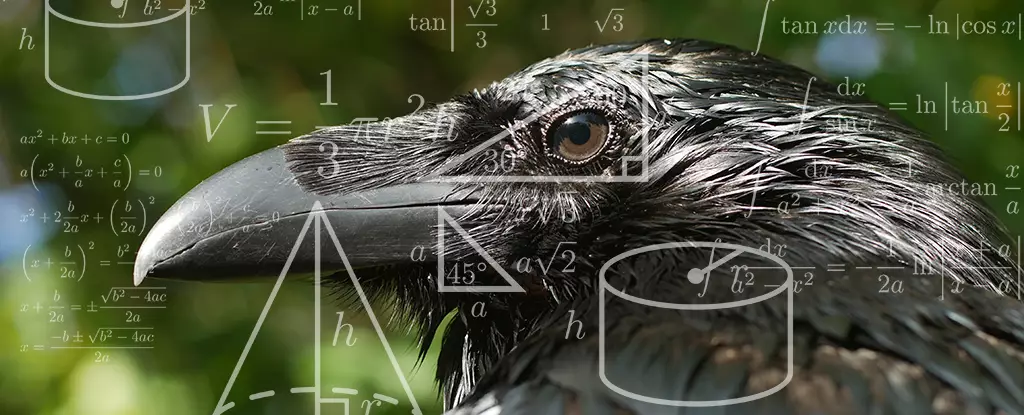In a world that often dismisses non-human creatures as mere automatons, a fresh study reveals that crows possess a cognitive ability that rivals our own—an intuitive understanding of geometric shapes. This revelation not only shines a light on the intelligence of these shadowy avians but also forces us to reevaluate the boundaries of human exceptionalism. The implications are staggering; if crows can discern geometric regularity as adeptly as we do, then the essence of cognitive ability may be more pervasive in the animal kingdom than we ever imagined.
Crows: Nature’s Slow Burn in Cognitive Evolution
Andreas Nieder and his colleagues at the University of Tübingen conducted experiments with two adult carrion crows, who displayed a remarkable skill for identifying ‘the odd one out’ among geometric shapes. Crows are not just pecking at random; they showcase a sophisticated understanding of regularity—especially in shapes like squares and rectangles—displaying a cognitive affinity that places them among an elite intellectual club of non-human beings. These findings challenge us to reconsider not just how we perceive crows, but also our understanding of cognitive evolution itself. If geometric intuition is rooted deep in our evolutionary tree, it marks a profound shift in the narrative of intelligence.
The Experiment: A Window into Their Minds
The setup of the experiment was somewhat unassuming: the crows were trained on a computer to identify a solitary shape among identical companions. What made this study interesting was the unique design, ensuring that the crows relied on pre-existing geometric sensibilities rather than learned behaviors. Such careful structuring is necessary to draw authentic conclusions about cognitive capabilities, and it underscores the experimental rigor that led to these groundbreaking insights.
But what stands out is not merely the experiment itself, but the broader realization that crows—intelligent and adaptable as they are—are contextual creatures. Their ability to navigate both familiar and alien environments using geometric cues allows for survival advantages in the wild, suggesting that these abilities are not circumstantial but evolutionarily significant.
The Nuances of Geometric Recognition
Interestingly, the study revealed that crows encountered the most difficulty with a rhombus, a detail that opens up discussions about cognitive biases within animal minds, mirroring the human struggle with less familiar geometric forms. This fascinating similarity between human and avian cognition demands a moment of introspection: if both species find certain shapes challenging, could it be that our geometric challenges stem from fundamentally shared evolutionary experiences? This is a question that lingers uncomfortably, nudging us to reconsider what supremacy in intelligence really means.
Implications of Geometric Intuition in Crows
The implications extend beyond mere observation. If these birds utilize spatial regularities for navigation and broader environmental understanding, as Nieder asserts, it reveals a sophisticated cognitive architecture that has long been underestimated. The core knowledge of geometry as an evolutionary trait has profound implications for how we understand communication, cognition, and social structures in animals. What other creatures might also possess unrecognized cognitive faculties? Are we discounting the intelligence of those we consider ‘lesser’ creatures based solely on anthropocentric perspectives?
This study is not merely an academic exercise; it serves as a critical lens through which we can scrutinize our relationships with other species. It challenges us to shed the lens of superiority that has traditionally categorized human intelligence as singular and superior. After all, one cannot escape the irony that as we marvel at the emotional complexity and intelligence of crows—creatures often portrayed in folklore as shadows of darkness—we may inadvertently reflect on our own cognitive shortcomings.
A Call for Respect and Understanding
As we stand at the crossroads of this cognitive revolution in understanding animal intelligence, it is not just a matter of academic interest but a call to respect and understand the myriad forms of intelligence that populate our world. Crows, with their newfound geometric prowess, remind us of the rich tapestry of life forms capable of complex thought and understanding. Our challenge now lies in acknowledging these multifaceted beings as equal participants in the grand mosaic of existence, deserving of our attention, respect, and perhaps even a touch of humility. The intelligence of crows is not just illuminating; it’s transformative. The more we uncover, the more we redefine what it means to be ‘intelligent’ in a world filled with equal competitors for that title.


Leave a Reply